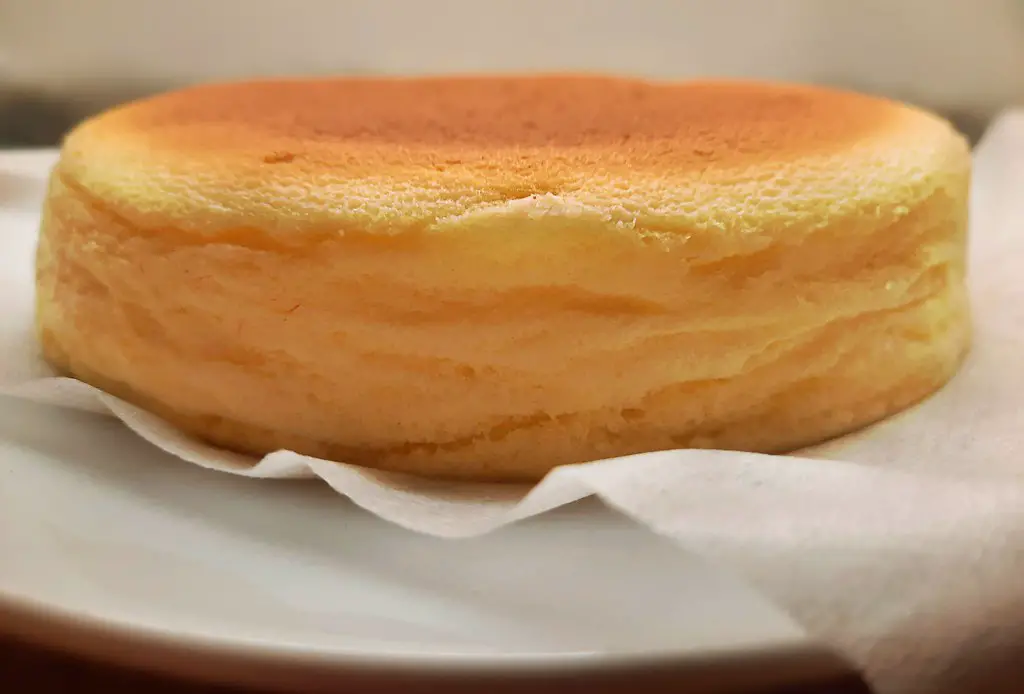Japanese Cheesecake, often known as “cotton cheesecake” or “soufflé cheesecake,” has won the hearts of dessert aficionados worldwide. Known for its feather-light texture and subtle sweetness, this dessert offers a delightful contrast to its denser New York-style counterpart. In this article, we’ll guide you through the process of creating this airy delight, ensuring your baking adventure leads to fluffy perfection.
Ingredients
Before diving into the method, let’s gather the necessary ingredients. This recipe serves 8:
Cream Cheese – 250g, softened
Unsalted Butter – 60g
Whole Milk – 100ml
Eggs – 6 large, separated
Sugar – 140g, divided
Lemon Juice – 1 tablespoon
Cake Flour – 60g
Cornstarch – 20g
Salt – a pinch
Cream of Tartar – 1/4 teaspoon (optional)
Equipment
Round 9-inch (23 cm) springform pan
Parchment paper
Double boiler or heatproof bowl over a pot
Electric mixer
Fine-mesh sieve
Rubber spatula
Instructions
Prep Work
Preheat your oven to 160°C (320°F). Line the bottom and sides of the springform pan with parchment paper, ensuring the paper extends higher than the rim to accommodate the cheesecake’s rise.
Cheese Base
In a double boiler, gently melt the cream cheese, butter, and milk. Keep the heat low to avoid cooking the cheese. Once melted, whisk the mixture until smooth and allow it to cool slightly.
Egg Yolks Mixture
Separate the egg whites and yolks. In a separate bowl, whisk the egg yolks and then gently incorporate them into the cooled cheese mixture. Add lemon juice.
Dry Ingredients
Sift the cake flour, cornstarch, and a pinch of salt into the cheese and yolk mixture. Whisk until just combined, ensuring not to overmix.
Meringue
In a clean, dry bowl, whip the egg whites at medium speed. As they begin to foam, add the cream of tartar (if using) and half the sugar. Gradually add the remaining sugar and beat until the egg whites reach stiff peaks.
Combine
Gently fold a third of the meringue into the cheese mixture using a rubber spatula. Repeat with the remaining meringue in two more additions. Be careful to maintain the airiness of the meringue.
Baking
Pour the batter into the prepared pan. Place the pan in a larger roasting pan and fill the roasting pan with boiling water until halfway up the side of the cake pan. This water bath helps cook the cake gently and evenly.
Bake for 60-70 minutes, or until set but still wobbly in the center. Turn off the oven and leave the door ajar, letting the cake cool in the oven for about 1 hour to prevent collapse.
Serving
Once cooled, remove from the pan and peel off the parchment paper. For the best flavor and texture, chill in the refrigerator for a few hours before serving.
Tips for Success
Room Temperature Ingredients: Ensure all ingredients are at room temperature before beginning.
No Overmixing: Overmixing can deflate the batter. Fold gently and just until combined.
Oven Temperature: Accurate oven temperature is crucial. Consider using an oven thermometer to verify.
Cooling: Let the cheesecake cool gradually in the oven with the door ajar to prevent cracking.
Japanese Cheesecake is a delightful treat that’s perfect for those who love their desserts light and airy. By following these steps and tips, you’ll be well on your way to creating a delectable, cloud-like cheesecake that is sure to impress.
Variations and Serving Suggestions
While the classic Japanese Cheesecake is a delight in itself, there’s always room for creativity and customization. Here are some variations and serving suggestions to elevate your cheesecake experience:
Flavor Variations
Matcha: Add 2 tablespoons of matcha powder to the flour mixture for a Japanese twist.
Chocolate: Melt 100g of chocolate and fold it into the batter for a chocolate version.
Citrus Zest: Incorporate lemon or orange zest into the batter for a citrusy aroma.
Toppings
Fresh Fruit: Top with fresh berries, sliced kiwi, or citrus segments for a refreshing touch.
Whipped Cream: A dollop of lightly sweetened whipped cream can complement the cheesecake’s lightness.
Powdered Sugar: A simple dusting of powdered sugar just before serving adds a touch of sweetness.
Serving Ideas
Tea Pairing: Serve with a cup of green tea or a light oolong to enhance the overall experience.
Mini Cheesecakes: Consider making individual mini cheesecakes using muffin tins for a party-friendly option.
Storage and Make-Ahead Tips
Japanese Cheesecake keeps well, making it a convenient make-ahead dessert:
Refrigeration: Store in an airtight container in the refrigerator for up to 5 days.
Freezing: Wrap the cheesecake tightly in plastic wrap and freeze for up to a month. Thaw in the refrigerator overnight before serving.
Common Mistakes to Avoid
Not Creaming the Cheese Well: Lumps in the cheese base will affect the texture. Ensure it’s smooth and creamy.
Under or Over Beating Egg Whites: Getting the right consistency for the meringue is crucial for the cake’s texture. Stiff, but not dry, peaks are ideal.
Opening the Oven Too Early: Resist the temptation to open the oven door, as sudden temperature changes can cause the cheesecake to collapse.
Mastering the Japanese Cheesecake may seem daunting at first, but with patience and practice, it’s an incredibly rewarding endeavor. This delicate dessert is not just about the taste; it’s about the art of baking and the joy of sharing a light, fluffy slice of heaven with friends and family. Whether you stick to the classic recipe or venture into variations, each slice of Japanese Cheesecake is a testament to the finesse and delicacy of Japanese baking. Happy baking, and enjoy your culinary masterpiece!
Frequently Asked Questions About Japanese Cheesecake
Why did my Japanese Cheesecake crack on top?
Cracking is often due to sudden temperature changes. To prevent this, make sure your oven temperature is accurate and avoid opening the oven door while baking. Also, let the cheesecake cool gradually in the oven with the door slightly ajar.
Can I make Japanese Cheesecake without a springform pan?
Yes, you can use a regular round cake pan. Just make sure to line it thoroughly with parchment paper for easy removal. A springform pan is recommended for its convenience.
How do I know when the cheesecake is done baking?
The cheesecake should be firm around the edges but still slightly wobbly in the center. It will set completely as it cools.
Why is my cheesecake not fluffy?
This can happen if the egg whites were not beaten to the correct stiffness, or if the batter was overmixed, causing deflation. Make sure to fold the egg whites gently into the batter.
Can I substitute cream cheese with another type of cheese?
The unique texture and flavor of Japanese Cheesecake rely heavily on cream cheese.
Substituting it with another type of cheese will significantly alter the results.
How can I prevent the bottom of the cheesecake from getting soggy in the water bath?
Wrap the bottom of your springform pan with aluminum foil to prevent water from seeping in.
Also, make sure the water bath isn’t too full.
Is it necessary to use a water bath?
While not absolutely necessary, a water bath helps provide gentle heat around the cheesecake, which is key for its smooth, creamy texture and preventing cracks.
How long should I cool the cheesecake before serving?
Let it cool in the oven for about an hour, then refrigerate for at least 4 hours, ideally overnight. This ensures the cheesecake sets properly and develops the right texture.
Can I reduce the sugar in the recipe?
Yes, you can reduce the sugar slightly, but keep in mind that it might slightly alter the texture and flavor balance of the cheesecake.
Why did my cheesecake shrink?
A little shrinking is normal as the cheesecake cools. However, significant shrinking often indicates overmixing or overcooking.
Remember, baking is as much a science as it is an art. Minor variations in ingredients, techniques, and oven characteristics can make a big difference. Don’t be discouraged by initial setbacks. Practice and patience are key to mastering the art of making the perfect Japanese Cheesecake!




